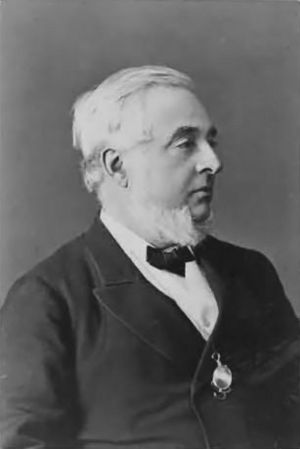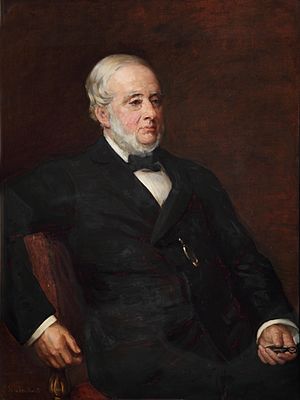Warren De la Rue facts for kids
Quick facts for kids
Warren De la Rue
|
|
|---|---|
 |
|
| Born | 18 January 1815 |
| Died | 19 April 1889 (aged 74) Marylebone, London, England
|
| Spouse(s) |
Georgiana Bowles
(m. 1840) |
| Children | 5 |
| Parent(s) |
|
Warren De la Rue (born January 18, 1815 – died April 19, 1889) was a British scientist. He was an astronomer, a chemist, and an inventor. He is best known for being a pioneer in taking photos of space objects.
Contents
Biography
Warren De la Rue was born in Guernsey, on the Channel Islands. His father, Thomas de la Rue, started a big stationery company in London. Warren went to school in Paris. After school, he joined his father's business. In his free time, he studied chemistry and electricity. He wrote several papers about these topics between 1836 and 1848.
Early Inventions
In 1840, Warren De la Rue made one of the world's first electric light bulbs. He put a special platinum wire inside a vacuum tube. Then he passed electricity through the wire. The platinum wire would glow brightly. Platinum has a very high melting point. This meant it could get very hot without melting. The vacuum inside the tube also helped the bulb last longer. This was a very good design. However, platinum was too expensive to use for light bulbs for everyone.
Astronomy Work
Warren De la Rue became interested in astronomy because of James Nasmyth. In 1850, he built a large 13-inch reflecting telescope. He first set it up in Canonbury, then later in Cranford, Middlesex. With this telescope, he drew many beautiful and accurate pictures of space objects.
Pioneering Space Photography
His most famous work was using photography for astronomy. In 1851, he saw a photo of the Moon taken by George Phillips Bond. This photo was a daguerreotype. Warren De la Rue wanted to take even better photos. He started using a faster method called the wet-collodion process. Soon, he took incredibly clear pictures of the Moon. These photos were the best until 1865. A crater on the Moon is named De La Rue in his honor.
Studying the Sun
In 1854, he started studying the Sun. He wanted to take daily photos of the Sun's surface. For this, he invented the photoheliograph. He described this invention in a report in 1859. Regular work with this machine began in 1858 at Kew. It continued there for 14 years. Then it moved to the Royal Greenwich Observatory from 1873 to 1882. He also wrote two important papers about his Sun research. He worked with Balfour Stewart and Benjamin Loewy on these papers.
Solar Eclipse Expedition
In 1860, De la Rue took his photoheliograph to Spain. He wanted to photograph a total solar eclipse that happened on July 18. The photos he took during this trip were very important. They proved that the bright red flames seen around the Moon during an eclipse actually come from the Sun. In 1873, De la Rue stopped his active astronomy work. He gave most of his astronomy tools to the university observatory in Oxford. Later, in 1887, he gave them another telescope. This was a 13-inch refractor telescope. It helped the observatory join the Carte du Ciel, a big project to map the sky with photos.
Other Research and Honors
Warren De la Rue also worked with Dr. Hugo Müller. Between 1856 and 1862, they published several papers on chemistry. From 1868 to 1883, they studied how electricity moves through gases. They used a very large battery with 14,600 cells for this. He was the president of the Chemical Society twice. He also led the Royal Astronomical Society from 1864 to 1866. In 1862, he received the gold medal from the Royal Astronomical Society. In 1850, he became a Fellow of the Royal Society. In 1864, he received their Royal Medal. This was for his photos of the 1860 solar eclipse and his improvements in space photography.
Warren De la Rue passed away in Marylebone in 1889. He was married to Georgiana Bowles. They had four sons and one daughter.
Honours and awards
- He received the Gold Medal of the Royal Astronomical Society in 1862.
- He was given the Royal Medal from the Royal Society in 1864.
- He won the Lalande Prize in 1866.
- The De La Rue crater on the Moon is named after him.
- He was made a Commander of the Legion of Honor (France).
- He was made a Commander of the Order of St. Maurice and St. Lazarus (Italy).
- He was made a Knight of the Imperial Order of the Rose (Brazil).
See also
 In Spanish: Warren de la Rue para niños
In Spanish: Warren de la Rue para niños


